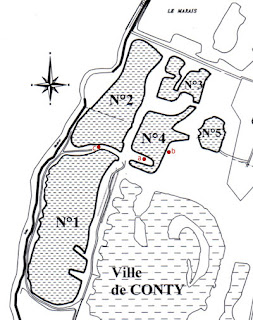I took Tom out on our first fishing trip. We went via the Café in Conty to pick up our licences for the year and a day-pass for the trout lake (Etang N°4).
We met the Gard-de-Pêche at the lake and he gave us the Reglement 2007. After checking out how the other guys were fishing we set about fishing for some trout.
The place has some funny rules: such as closing for lunch between 12 and 2pm, so as we had arrived just before 12, we didn't have long to fish in the morning. Tom had a couple of casts (point 'a', below). We were able to go to the N°2 lake (point 'c', below) where Tom's junior licence allows him to fish there too. I gave some advice and made lunch. I think that I'm going to get him fishing for Pike (Brochet) next time.
2pm and we were back fishing at the N°4 trout lake at point 'a', below. We then moved on to another spot (point 'b', below).
We had a good day, but alas, no fish. We used our old trout paste as bait. Perhaps a little old... if this stuff does get old - it still stinks like fish.
We saw a giant trout patrolling the bank that swam right under out lines at out feet without a care to the world.
Tom has learnt to cast very well. He is using a light rig: 183cm graphite rod and Regal-S 1500T Daiwa ultralight reel.
I was using my 259cm carbon fly rod and a fly reel and sinking grey fly line - not the best tackle for a still water lake.
#10 hooks and orange Power Bait paste. The other guys were using red and white paste.
Tom is fishing in the Carp lake (N°2) during the pause for lunch on lake N°4:

























